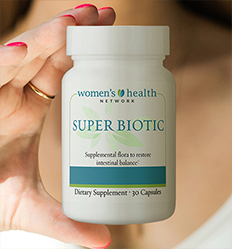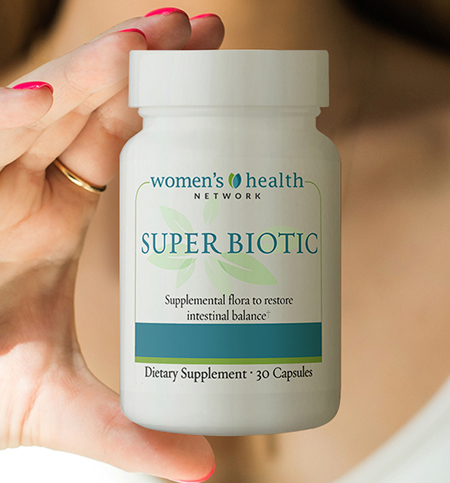When it comes to estrogen, the message most women get is to worry about the hormone only when levels start to decline in menopause. The truth is, high estrogen levels are just as much cause for concern – and can happen in any phase of a woman’s life.

High estrogen – also known as “estrogen dominance” – refers to an imbalance of too much estrogen relative to progesterone. When estrogen is dominant, it can trigger a host of problematic symptoms, from irregular periods, breast tenderness, low libido and weight gain to fatigue, uterine fibroids and even increased risk for certain cancers. Estrogen dominance can be caused by an underlying hormonal disorder like PCOS, but it’s also commonly associated with diets high in processed foods and sugars, exposure to everyday environmental toxins, and high levels of stress.
If estrogen dominance is at the root of your health concerns, then the reassuring news is that nutrition and diet are potent tools for restoring hormonal balance. When properly fueled with the nutrients it needs, the body has an amazing ability to normalize healthy production and metabolism of estrogen and all your other hormones – diminishing symptoms and helping you feel like yourself again.
The best diet for estrogen dominance is plant-filled, nutrient-dense – and delicious!
So, what do you eat to rebalance estrogen? As research shows, when you adopt a Mediterranean-style diet, which is predominantly plant-based, fiber rich and nutrient dense, with plenty of healthy fats and lean protein, it can help support your hormone producing and eliminating systems, bringing hormones back into balance, while offering a host of additional benefits as well.
The best thing about this estrogen dominance “diet” is that it is highly sustainable: rather than focus on eliminating food groups, it focuses on incorporating a wide variety of satisfying foods into your diet so that promoting healthy estrogen metabolism and hormonal balance really becomes a lifestyle to enjoy.
Foods that support estrogen metabolism and excretion
The ovaries, adrenal glands and fat tissue produce estrogen. The liver then metabolizes, or breaks down, estrogen after it has performed its various functions in the body. Finally, the digestive system helps eliminate it. When trying to correct an estrogen imbalance, it makes sense to do what we can to support these systems.
Detoxifying system & the liver
The liver plays a central role in the detoxification of estrogen and other substances, making it essential to maintain its optimal function. If your liver is not in tip top shape, then this could be a big reason why your estrogen levels are off. We can begin to support our livers by eating a variety of whole foods that can provide the micronutrients our body needs. There are many liver-friendly food choices to help you get these nutrients in ideal amounts.
| Nutrient | Role for the Liver | Where to Find It |
| Selenium | Trace mineral Antioxidant that protects liver cells | Selenium is found in many foods such as seafood, meat, poultry, grains, beans, nuts, eggs Deficiency is rare |
| Glycine | Amino acid Clears toxins from the body | Clean red meats, poultry, seeds, soybeans, bread, almonds, eggs, beans |
| Sulforaphane | A sulfur rich compound that improves liver function | Cruciferous vegetables such as Brussels sprouts, cauliflower, mustard greens, broccoli |
| Magnesium | Micronutrient that plays a role in liver functions including energy production | Pumpkin seeds, hemp seeds, dark leafy greens |
| Indole-3 carbinol | A compound that stimulates detoxifying enzymes in the liver and the gut and makes Diindolylmethane (DIM) which supports the liver, promotes regularity and assists estrogen metabolism | Cruciferous vegetables in the Brassica family such as cabbage, broccoli, kale, Brussels sprouts, rutabaga, turnips and cauliflower |
| Catechins | Natural polyphenolic phytochemicals which may metabolize estrogen | Fruits, vegetables, tea, green tea |
Before taking supplements, consult a doctor as over consumption of some of these nutrients can cause further strain on the liver. First try to get your nutrients from foods, then you can fill in any gaps.
Digestive system & gut health
Once the liver breaks down estrogen, bacteria in the gut breaks down and modulates it further. This metabolized estrogen then gets packed up in the digestive system and eliminated as waste.
Frequent constipation and lack of digestive enzymes can keep estrogen trapped in the gut where it can be reabsorbed back into the body instead of eliminated. Supporting gut health with plenty of fiber rich foods, replenishing your gut flora with probiotics and proper hydration are important. I’ll give you more tips on this in the following section!
Food choices & practices that balance estrogen
Now let’s get specific about the dos and don’ts of your estrogen dominance diet. First the “dos” of your estrogen diet…
Include more of these foods:
Fiber
Fiber is an unsung hero for gut health and hormonal health. It feeds the good bacteria in the gut and slows down digestion, allowing our bodies to absorb the nutrients we need. Fiber also binds up estrogen, reduces its absorption in the colon and encourages its excretion, helping to bring down high estrogen levels.
Women should be getting between 21-28 grams of fiber per day. Aim for plenty of fruits and vegetables with the skin on, because that’s where most of the fiber is found.
To see if you’re getting enough, simply jot down everything you eat in a day and then use an online calculator like My Fitness Pal to tally up your fiber. You might be surprised that you are getting a lot, or learn that this is an area of your diet where you need to put more focus.
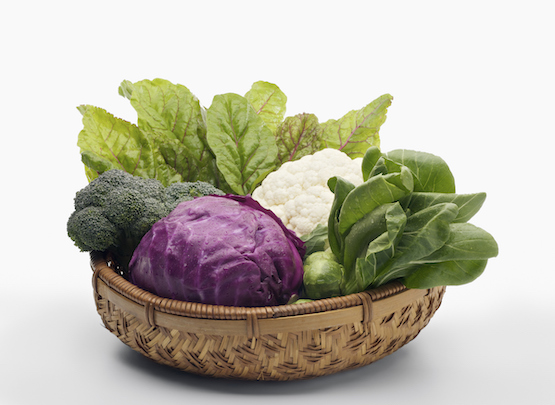
Cruciferous Vegetables
Not only are they full of fiber and nutrients that are beneficial to gut health, but when we chew and digest cruciferous vegetables in the Brassica family, a special sulfate-containing compound called diindolylmethane (DIM) is formed. This compound is thought to modulate the detoxification of estrogen. Try including:
- Cabbage
- Broccoli
- Kale
- Brussels sprouts
- Cauliflower
- Collards
- Bok Choy
Even if you’re eating lots of greens daily, you may not be eating enough of these cruciferous vegetables. Aim for 1-2 cups of these powerhouse veggies in your diet each day.
Soluble fiber
Found in starchy root vegetables and legumes, soluble fiber binds to estrogen and encourages its excretion. Psyllium husk is a soluble fiber which binds to estrogen and promotes regularity, reduces inflammation and is a prebiotic which fuels the gut microbiome. Psyllium can interact with many medications, so if you’re taking one, be sure to check with your doctor first before using.
Insoluble fiber
The other main type of fiber also binds to estrogen and reduces the absorption of cholesterol, which is a precursor to estrogen and may help reduce the circulating levels of estrogen in the blood. Great sources of insoluble fiber include whole grains such as brown rice and vegetables with seeds.
Probiotic foods
Yogurt, kefir, sauerkraut, tempeh, miso, kimchi and kombucha… Foods rich in probiotics provide the gut with flora that help with estrogen detoxification. Sauerkraut and kimchi provide a double benefit: they are both from the Brassica family and fermented!
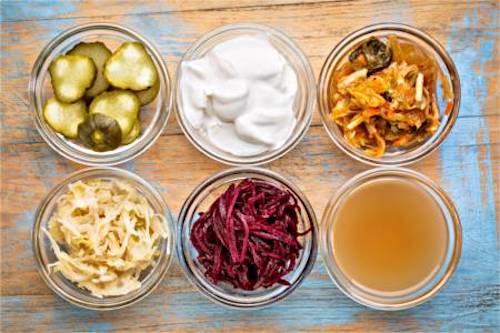
Vitamin C
The powerhouse antioxidant vitamin may help increase levels of progesterone which can help balance out the levels of estrogen in the body. Vitamin C is found in many fruits and vegetables such as bell peppers, kiwi fruit and plenty of whole citrus fruits (not just the juice).
Phytoestrogens
These natural plant-based compounds mimic estrogen in the body. Because they have a structure similar to estrogen, phytoestrogens can compete with the body’s natural estrogen for receptor sites in tissues. By binding to estrogen receptors, they may help reduce the overall estrogenic effect in the body, particularly if estrogen levels are excessively high.
Phytoestrogens can be found in ground flax seeds. Other sources of phytoestrogens include legumes like chickpeas, black beans and mung beans, sesame seeds, garlic, dried apricots, prunes and dates, fresh parsley, dill and sage, green tea, fennel seed and aniseed, and organic tempeh and miso. Soy is rich in phytoestrogens but is a hotly debated food. The most recent research shows that consuming soy does not elevate estrogen levels and has in fact been associated with lower levels of cancer. Soy contains not only phytoestrogens, but fiber and protein as well.
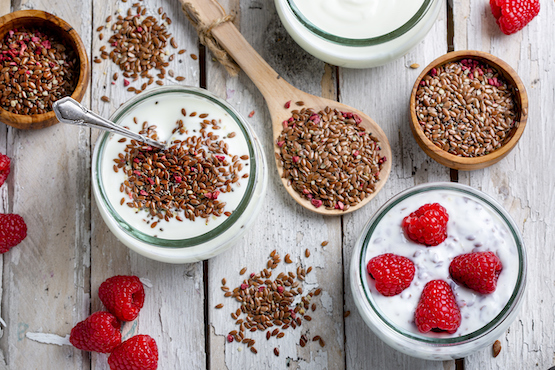
Lean protein
Protein plays a crucial role in the formation and regulation of hormones in the body
Our bodies need protein to build and repair muscle tissue. It is essential for our livers, our brains and our digestive system.
Protein may come from either plant or animal sources. Meat, fish and poultry provide a complete protein source.
Plant-based complete proteins include soy, quinoa, hemp, chia and tempeh. Vegetarians and vegans need to be sure to be combining incomplete plant-based proteins, like rice and beans, to get all of the essential amino acids from their protein sources.
Swapping out red meats and processed meats with quality animal protein or complex plant protein sources is key.

Healthy fats
Since estrogen is produced in our fat tissue, having excess body fat can lead to excess production of estrogen. So while it sounds counterintuitive to eat fats to avoid excess fat, that is exactly what we need to do. Swapping out processed fats and oils — like canola and soybean oil, which can be inflammatory with healthy fats is key.
Sources of healthy fats are mostly those that come from whole plants like:
- avocado
- coconut
- olives
- walnuts
- chia seeds
- organic cold pressed unrefined oils including olive oil, avocado oil and coconut oil
Healthy fats can also come from animal sources including:
- salmon
- sardines
- grass fed butter and ghee
- Eggs
Be sure to add in plenty of Omega-3 and 6, the building blocks and backbone of hormones. Rich sources of omegas include
- wild fatty fish such as salmon and sardines
- flax seed
- chia seeds
- walnuts
Another benefit of healthy fat is that it produces the hormone leptin which is our satiety hormone. Leptin helps us control our weight by telling us when to stop eating. Eating a very low fat diet encourages our brains to tell us to keep on eating which leads to overeating and weight gain.
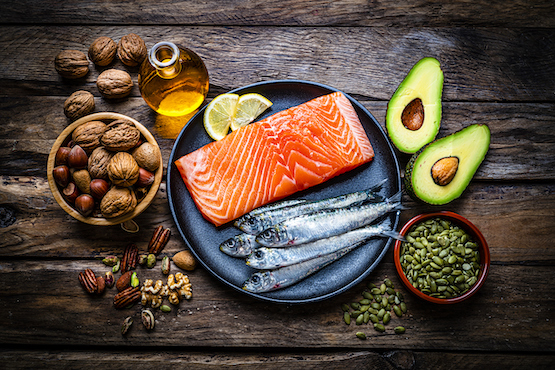
Hydration
Drinking plenty of water is important for several reasons. First of all, fiber requires water to be digested properly. It absorbs water in the intestines which bulks up stool. Staying hydrated helps to avoid constipation, gas and bloating.
Secondly, drinking plenty of water helps to flush toxins and remove excess estrogen. Even better is drinking filtered water in order to remove potential xenoestrogens (toxins that mimic estrogen).
Aim for drinking half of your bodyweight in ounces.
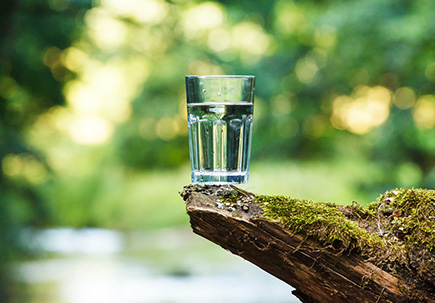
Aim for organic
Eating organic whenever possible reduces exposure to toxins called “xenoestrogens” that mimic estrogen in the body, leading to unnaturally high levels of the hormone. Refer to the Environmental Working Group’s Clean 15 and Dirty Dozen for more information on making healthy choices.
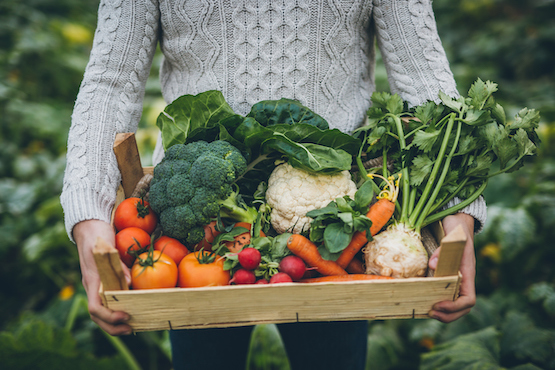
Foods & food practices to avoid
Though the benefit of the “estrogen dominance diet” is that we get to incorporate all sorts of delicious foods, there are a few things to avoid.
- Refined carbohydrates and added sugars promote unstable blood sugar levels which can lead to insulin instability.
- Caffeine is believed to increase estrogen
- Non organic soy is sprayed with pesticides that may interfere with estrogen metabolism
- Alcohol taxes the liver and the gut, the two systems which we are trying to support with the estrogen dominance diet. Excessive alcohol interferes with estrogen metabolism in the liver and can also kill the good bacteria and flora in the gut.
- Toxins like too much caffeine and alcohol and unnecessary drugs or over-the-counter medicines can burden our systems
- Avoiding non-stick cookware and heating foods in the microwave using glass and not plastic are practices that also help to reduce xenoestrogen exposure.
Eating for estrogen balance is permission to nourish yourself
Maintaining healthy estrogen metabolism and hormonal balance is a vital aspect of overall well-being for all women. Thankfully, the “estrogen dominance diet” offers a refreshing perspective on achieving this balance. Remember, it’s not about restriction but about enjoying a variety of delicious, nutrient-dense foods that support your body’s natural hormonal balance.
Switching to a Mediterranean-inspired diet that’s full of plant-based, fiber-rich and nutrient-packed foods, along with healthy fats and lean proteins, can be a delightful and long-lasting dietary choice. It not only aids in restoring balance to your hormone production and elimination systems but also comes with numerous extra health perks.
Start small by adding one fiber rich food to each meal and snack and eating a cup of cruciferous vegetables a day. Remember, hydration is also a crucial component, aiding digestion, toxin removal and estrogen balance.
So, embark on this journey towards hormonal harmony and optimal well-being, making the “estrogen dominance diet” an integral part of your life. Your body will thank you, one delicious, nutritious bite at a time.
References
What we eat in America
U.S. Department of Agriculture, Agricultural Research Service. 2016. Nutrient Intakes from Food and Beverages: Mean Amounts Consumed per Individual, by Gender and Age, What We Eat in America, NHANES 2013-2014.
Baker JM, Al-Nakkash L, Herbst-Kralovetz MM. Estrogen-gut microbiome axis: Physiological and clinical implications. Maturitas. 2017 Sep;103:45-53. doi: 10.1016/j.maturitas.2017.06.025. Epub 2017 Jun 23. PMID: 28778332.
Environmental Working Group Clean 15
Environmental Working Group Dirty Dozen
Phytochemical
Lecomte S, Demay F, Ferrière F, Pakdel F. Phytochemicals Targeting Estrogen Receptors: Beneficial Rather Than Adverse Effects? Int J Mol Sci. 2017 Jun 28;18(7):1381. doi: 10.3390/ijms18071381. PMID: 28657580; PMCID: PMC5535874.
Soy and Estrogen
Does Soy Increase Estrogen and Cause Cancer?
Indole-3-carbinol strongly influences estradiol metabolism in humans and may provide a new chemopreventive approach to estrogen-dependent diseases
Michnovicz JJ, Bradlow HL. Induction of estradiol metabolism by dietary indole-3-carbinol in humans. J Natl Cancer Inst. 1990 Jun 6;82(11):947-9. doi: 10.1093/jnci/82.11.947. PMID: 2342128.
Women and Omega 3 Fatty Acids
Saldeen P, Saldeen T. Women and omega-3 Fatty acids. Obstet Gynecol Surv. 2004 Oct;59(10):722-30; quiz 745-6. doi: 10.1097/01.ogx.0000140038.70473.96. PMID: 15385858.
Caffeine and Estrogen







